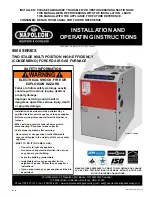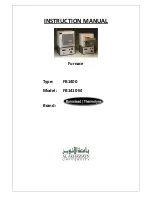
20
Figure 23. Alternate Removal Method
Screws
Front
Brace
Bottom
Panel
Screws
Blower
Deck
Door
GAS SUPPLY & PIPING
WARNING:
FIRE OR EXPLOSION HAZARD
• Failure to follow safety warnings exactly could
result in serious injury, death or property
damage.
• Installation and service must be performed
by a qualified installer, service agency or the
gas supplier.
• Do not store or use gasoline or other
flammable vapors and liquids in the vicinity
of this or any other appliance.
WHAT TO DO IF YOU SMELL GAS
• Do not try to light any appliance.
• Do not touch any electrical switch; do not
use any phone in your building.
• Leave the building immediately.
• Immediately call your gas supplier from a
neighbor’s phone. Follow the gas supplier’s
instructions.
• If you cannot reach your gas supplier, call
the fire department.
• All gas piping must be installed in compliance with
local codes and utility regulations. In the absence of
local codes the gas line installation must comply with
the latest edition of the National Fuel Gas Code (ANSI
Z223.1) or (CAN/CSA B149.1) Installation Codes.
• Some local regulations require the installation of a
manual main shut-off valve and ground joint union
external to the furnace as shown in
&
. The shut-off valve should be
readily accessible for service and/or emergency use.
Consult the local utility or gas supplier for additional
requirements regarding placement of the manual main
gas shut-off.
• Per ANSI 21.47, A 1/8-inch NPT plugged tapping,
accessible for test gauge connection, must be installed
immediately upstream of the gas supply connection to
the furnace external to the cabinet. If local codes allow
the use of a flexible gas appliance connector, always
use a new listed connector. Do not use a connector
that has previously serviced another gas appliance.
• Gas piping must never run in or through air ducts,
chimneys, gas vents, or elevator shafts.
• Compounds used on threaded joints of gas piping
must be resistant to the actions of LP propane gas.
• The main gas valve and main power disconnect to the
furnace must be properly labeled by the installer in
case emergency shutdown is required.
• Flexible gas connectors are not recommended for this
type of furnace but may be used if allowed by local
jurisdiction. Only new flexible connectors may be
used. Do not use a connector which has previously
serviced another gas appliance.
• A drip leg should be installed in the vertical pipe run
to the unit. See
lists gas flow capacities for standard pipe
sizes as a function of length in typical applications based on
nominal pressure drop in the line.
The furnace may be installed with either left or right side gas
entry. When connecting the gas supply, provide clearance
between the gas supply line and the entry hole in the furnace
casing to avoid unwanted noise and/or damage to the furnace.
Typical gas hookups are shown in
.
Leak Check
WARNING:
FIRE OR EXPLOSION HAZARD
Failure to follow safety warnings exactly could
result in serious injury, death or property
damage.
Never test for gas leaks with an open flame.
Use a commercially available soap solution
made specifically for the detection of leaks
to check all connections. A fire or explosion
may result causing property damage, personal
injury or loss of life.
After the gas piping to the furnace is complete, all connections
must be tested for gas leaks. This includes pipe connections
at the main gas valve, emergency shutoff valve and flexible
gas connectors (if applicable). The soap and water solution
can be applied on each joint or union using a small paintbrush.
If any bubbling is observed, the connection is not sealed
adequately and must be retightened. Repeat the tightening
and soap check process until bubbling ceases.
IMPORTANT NOTE:
When pressure testing gas supply lines at pressures
greater than 1/2 psig (14 inch W.C.), the gas supply
piping system must be disconnected from the furnace
to prevent damage to the gas control valve. If the test
pressure is less than or equal to 1/2 psig (14 inch W.C.),
close the manual shut-off valve.
High Altitude Application (Natural Gas Only)
High altitude conversion with this furnace depends on
the installation altitude and the heating value of the gas.
Installation of this furnace at altitudes above 2,000 feet
shall be in accordance with local codes, or in the absence
of local codes, the National Fuel Gas Code, ANSI Z223.1/
NFPA 54 or National Standard of Canada, Natural Gas &
Propane Installation Code CSA B149.1. Please consult your
local code authority.











































